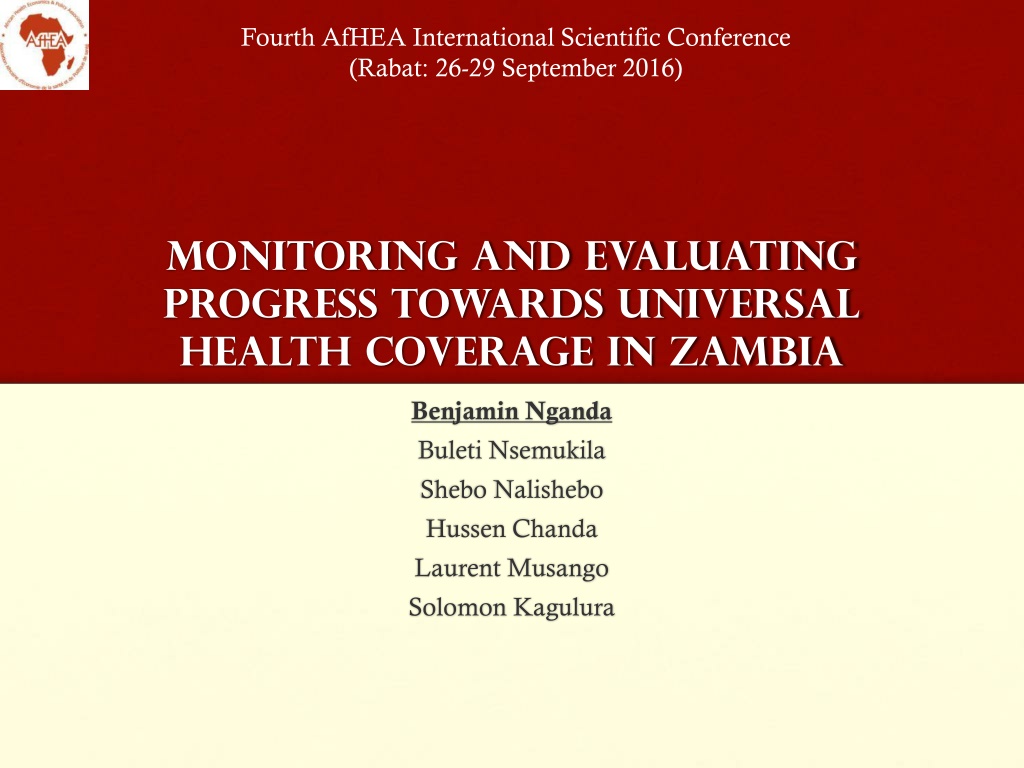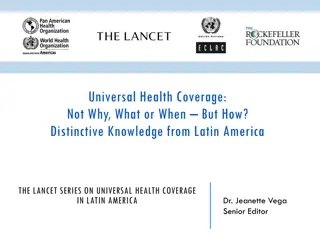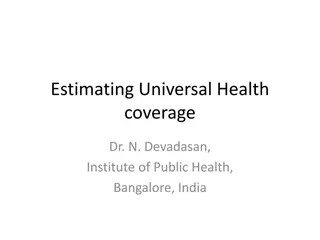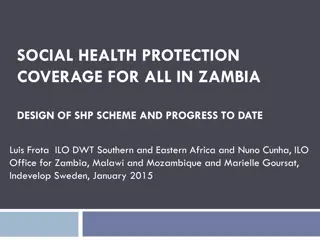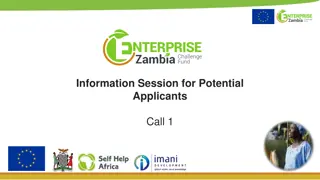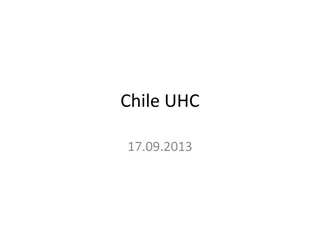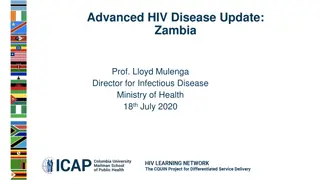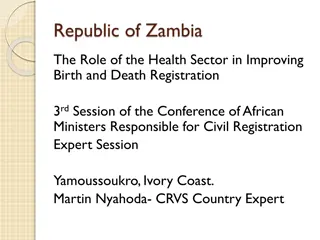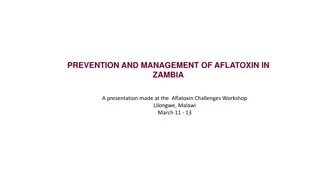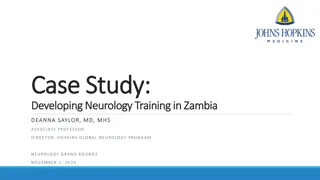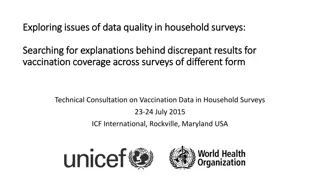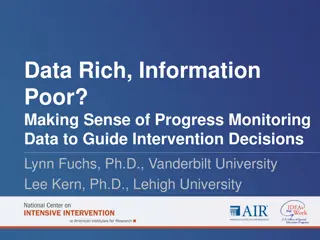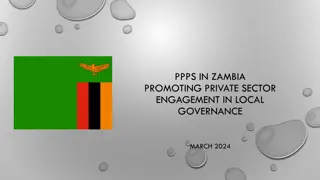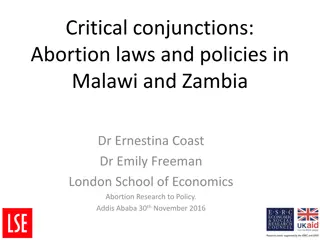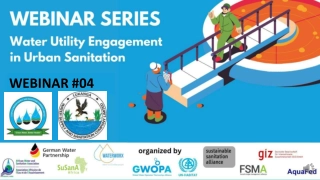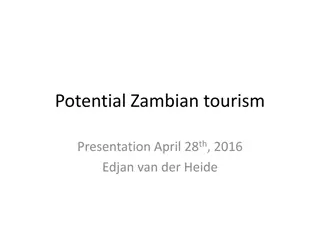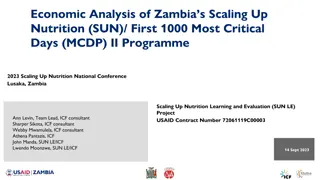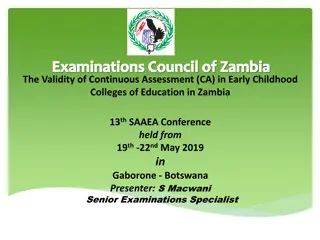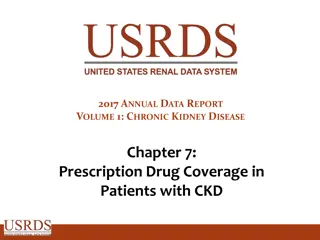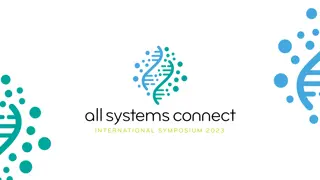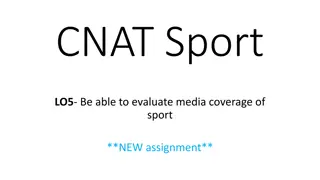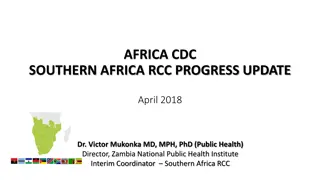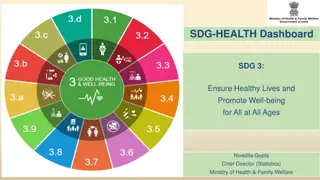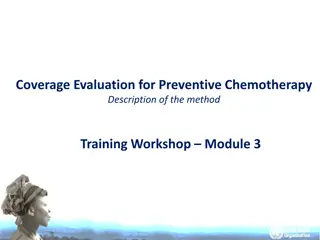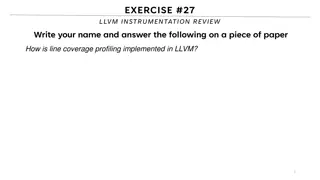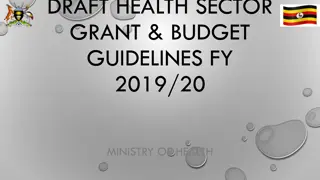Monitoring and Evaluating Progress Towards Universal Health Coverage in Zambia
This paper presented at the Fourth AfHEA International Scientific Conference in Rabat discusses the importance of monitoring progress towards Universal Health Coverage (UHC) in Zambia. It assesses Zambia's ability to report on the WHO/World Bank UHC indicators, reviews the policy context, and evaluates data sources for monitoring UHC indicators. By using the WHO/World Bank UHC monitoring framework, the study provides insights into tracking UHC progress in Zambia.
Download Presentation

Please find below an Image/Link to download the presentation.
The content on the website is provided AS IS for your information and personal use only. It may not be sold, licensed, or shared on other websites without obtaining consent from the author. Download presentation by click this link. If you encounter any issues during the download, it is possible that the publisher has removed the file from their server.
E N D
Presentation Transcript
Fourth AfHEA International Scientific Conference (Rabat: 26-29 September 2016) MONITORING AND EVALUATING PROGRESS TOWARDS UNIVERSAL HEALTH COVERAGE IN ZAMBIA Benjamin Nganda Buleti Nsemukila Shebo Nalishebo Hussen Chanda Laurent Musango Solomon Kagulura
Presentation Outline Background Methods The WHO/World Bank UHC Monitoring Framework Zambia The Policy Context Assessment of data sources for UHC monitoring indicators in Zambia Findings a UHC Profile of Zambia Conclusion and Recommendations Fourth AfHEA International Scientific Conference (Rabat: 26-29 September 2016)
Background Monitoring progress towards universal health coverage (UHC) ensuring that everyone who needs health services is able to get them, without undue financial hardship is critical to achieving the sustainable development goals (SDG) health outcomes goal and that of ending extreme poverty by 2030 Monitoring UHC in countries serves to ensure that progress towards UHC reflects a country s unique epidemiological and demographic profile, health system and level of economic development and the population s demands and expectations In 2014, the World Health Organization partnered with the World Bank and proposed a framework aimed to encourage countries to adopt a common approach to monitoring UHC and measuring progress with internationally standardized indicators In this paper we assess Zambia s ability to report on the WHO/World Bank UHC proposed indicators Fourth AfHEA International Scientific Conference (Rabat: 26-29 September 2016)
methods We used the WHO/World Bank UHC monitoring framework and other related supplementary documentation to benchmark Zambia s capacity to report on the proposed UHC monitoring indicators: We used the WHO/World Bank Framework to identify the indicators that Zambia will need to be tracking for monitoring UHC progress We reviewed the Zambian health policy to contextualize the environment in which UHC is being implemented Finally we assessed the availability of data on the proposed UHC indicators in the case of Zambia. We especially reviewed the sources of the data for these indicators and assessed their appropriateness/frequency, etc. Fourth AfHEA International Scientific Conference (Rabat: 26-29 September 2016)
THE WHO/WORLD BANK JOINT FRAMEWORK FOR UHC MONITROING /1 The framework is based on a results chain commonly used for monitoring and evaluating the progress and performance of specific programmes Health sector inputs such as financial resources, the health workforce, medicines, etc., are used to produce outputs such as access to quality services and increased coverage of interventions. These, through improved levels and distribution of health and well- being and improved health system responsiveness ultimately impact on health, leading to better health and improved household wealth and protection against poverty The health system policies that a country adopts at each step in this results chain, through their interaction with the social determinants of health, in turn determine the results at each step Fourth AfHEA International Scientific Conference (Rabat: 26-29 September 2016)
THE WHO/WORLD BANK JOINT FRAMEWORK FOR UHC MONITROING /2 Results chain framework for monitoring health sector progress and performance: Focus of UHC monitoring is here Source: T. Boerma et al, (2014), Figure 1 page 1. Fourth AfHEA International Scientific Conference (Rabat: 26-29 September 2016)
THE WHO/WORLD BANK JOINT FRAMEWORK FOR UHC MONITROING .../3 To make progress towards UHC, countries must therefore advance in terms of the health system inputs, outputs and coverage of good quality services in all population groups For monitoring progress towards UHC, the framework proposes a focus on the level and distribution of coverage of health interventions and on financial protection as integral to an overall tracking of the health system progress and performance The ultimate goal of UHC with respect to service coverage is that everyone can obtain the essential health services they need, that is, 100 percent coverage. However, taking into account problems that may be encountered in measuring need and effective coverage, the Framework specified a target of at least 80 percent coverage of essential health services, regardless of the level of wealth, place of residence or gender With respect to financial protection, the Framework noted that the available evidence suggests that a target that is both ambitious and achievable is 100 percent protection from both catastrophic and impoverishing health payments for the population as a whole as well as for all strata of the population Fourth AfHEA International Scientific Conference (Rabat: 26-29 September 2016)
THE WHO/WORLD BANK JOINT FRAMEWORK FOR UHC MONITROING.../4 Examples of proposed intervention coverage indicators by intervention area: Service Coverage Indicators: Prevention services: 1. Satisfaction of family planning needs 2. At least four antenatal care visits 3. Basic immunization coverage (measles vaccination in children) 4. Full immunization coverage (BCG, DPT3, 3 polio vaccines, & measles) 5. Improved water source 6. Adequate sanitation 7. Non-use of tobacco 8. Household ownership of insecticide-treated bed nets 9. Prevention of mother-to-child transmission service coverage 10. Contraceptive use (including condom use) Treatment services: 1. Skilled birth attendance 2. Antiretroviral therapy 3. Tuberculosis case detection 3. TB treatment success 4. Hypertension treatment 5. Diabetes treatment 6. Antiretroviral treatment (ARV) coverage 7. Percentage deliveries in health facilities Financial Risk Protection Indicators: 1. Out-of-pocket payments as a proportion of total health expenditure 2. Proportion of households incurring catastrophic health expenditure payments 3. Proportion of households making impoverishing out-of-pocket payments for health Fourth AfHEA International Scientific Conference (Rabat: 26-29 September 2016)
Zambia ECONOMIC AND HEALTH OUTLOOK Indicator Value Year Source Income classification: Lower middle income Ranking 2015 World Bank Population 16.21 million 2015 World Bank Gross domestic product USD 21.20 billion 2015 World Bank GDP per capita USD 1,844.80 2013 World Bank GDP growth rate: 6.7% annual change 2013 World Bank Human development index rank out of 188countries 139 2014 UNDP Life expectancy (at birth, years males/females): 59/65 2015 WHO Maternal mortality ratio per 100,000 live births 280 2013 WHO Under five mortality rate: 87.4 2013 WHO Infant mortality rate per 1,000 live births 55.8 2013 WHO Total fertility rate: 5.7 2013 WHO Total health expenditure as percent of GDP: 5.05 2014 WHO Total per capita expenditure on health: 195 USD 2014 WHO General government health expenditure % of total health expenditure 55 2014 WHO General government health expenditure as % of general government expenditure 11 2014 WHO Fourth AfHEA International Scientific Conference (Rabat: 26-29 September 2016)
UHC- The ZAMBIAN POLCY CONTEXT /1 Successive governments in Zambia have always aimed to achieve universal coverage At independence in 1964, Zambia inherited a health system a health care system fraught with widespread disparities The government set itself out a mission to expand access to health care services in order to improve equity through expanded infrastructure Economic challenges in the 1980 necessitated reforms which included introduction of user charges for health services which resulted in worsening of many key health indicators In 1990s a series of health reforms aimed at increasing equity of access to a cost effective, quality health care as close to the family as possible were put in place, with emphasis on involving the community using the PHC approach Fourth AfHEA International Scientific Conference (Rabat: 26-29 September 2016)
UHC- The ZAMBIAN POLCY CONTEXT /2 In 2005, all WHO Member States, Zambia included, made a commitment to achieve universal health coverage The country has been working on a Health Care Financing Policy and a Social Health Insurance (SHI) Strategy since 2008. This is yet to materialize Within the current 2012 National Health Policy, the Government has reiterated its desire to develop a health care financing strategy to ensure adequate and sustainable financing of the health sector Meanwhile access by the population to quality health services remains an area of concern Fourth AfHEA International Scientific Conference (Rabat: 26-29 September 2016)
Assessment of sources of data for UHC monitoring in Zambia Data Source Regularity Type of data available for UHC monitoring Latest available data year Accessibility (is the dataset/ database or reports) available? Not easy but staff could be trained to access and extract relevant/needed information yes Comments/Useful for what type of information? Current Routine Health Information Management System Service utilization indicators Collected on continuous basis Does not have data to assist in the assessment of financial risk protection. May be of limited use for coverage equity assessments. Four conducted so far. The latest being 2013/14. Limited in terms of service utilization for monitoring UHC. 2013/2014 Zambia Demographic and Health Survey Contains some service coverage indicators; may have equity related indicators such as age, region, etc. Service coverage indicators? Irregular 2-6 years: recently done in done 1992, 1996, 201/02, 2007, and 2013/14. 2009 Yes Zambia Sexual Behavior Survey Intermittent, done in 2005, 2009. May provide information relating to contraceptive use Service coverage indicators To be verified n.c. Zambia HIV/AIDS Service Provision Assessment Assessment report not retrieved May provide limited information for monitoring UHC e.g., on PMTCT and ARTs. May provide information ITNs ownership Does not have useful information like treatment success , etc. Estimate derived from WHO Service coverage indicators 2006, 2012 2012 Yes Zambia Malaria Indicator Survey Zambia Tuberculosis Surveys National Tuberculosis and Leprosy Programme: TB Manual Living Conditions Monitoring Surveys Service coverage indicators 2013-14 Yes 2006 Has limited useful data Treatment coverage indicators TB case detection Demographic information; Equity and financial protection Yes Has been done for a number of years but not periodic; 2010, 2015. Earlier surveys available Earlier survey may not be comparable to latter ones. Limited information on service utilization. May provide some information on financial protection. Under development should provide some information on financial risk protection If available could complement above sources n/a UHC Health Financing Strategy Possibly data on financial protection? First draft under preparation Not public yet in the public domain Health Utilization surveys Nil n/a n/a Service utilization indicators Fourth AfHEA International Scientific Conference (Rabat: 26-29 September 2016)
FINDINGS: PROGRESS TOWARDS UHC A PROFILE OF ZAMBIA /1 UHC Indicator Change Previous statistic Recent statistic Previous period Recent period Source (See legend at bottom of Table) Previous Recent .. 2 Satisfaction of family planning needs - percent At least four antenatal care visits - percent .. 72 64 56 Decline n/a .. 2013/14 2013/14 1 1 2001 Immunization coverage (measles vaccination in children) - percent 84 85 Increase 2007 2013/14 2 1 Immunization coverage (DPT3 immunization in children) - percent Improved water source - percent 56 63 50 Decline 68 Increase 2010 2013 2015 2015 4 1 7 7 Prevention Intervention Service Coverage Adequate sanitation percent 24 27 Increase 2007 2013/14 2 1 NCD prevention - non-use of tobacco - percent Household ownership of insecticide-treated bed nets (ITNs) - percent Prevention of mother-to-child transmission (PMCTC) knowledge - service coverage Contraceptive use (including condom use) - percent 86 53 63 90 Increase 68 Increase 89 Increase 2001 2007 2007 2013/14 2013/14 2013/14 3 2 2 1 1 1 41 49 Increase 2007 2013/14 2 1 Skilled birth attendance (births attended to by a skilled health worker (%)) 47 64 Increase 2007 2013 2 1 79 n/a 2012 11 Antiretroviral therapy coverage among people with HIV infection eligible for ART coverage according to 201 Guidelines Tuberculosis case detection percent Treatment 61 59 Decline undated 2014 8, 9 TB treatment success (new and relapse) percent Hypertension treatment Diabetes treatment Antiretroviral treatment (ARV) coverage - percent 88 .. .. 86 2013 9 95 Decline 2013 2014 10 10 Data sources: 1 Zambia Demographic and Health Survey 2013/2014 National Health Accounts, Zambia: Global Health Expenditure Database, World Health Organization. Geneva Zambia Living Conditions Monitoring Survey, 2015 8 The National Tuberculosis and Leprosy Programme: TB Manual 9 WHO 2015 Global Tuberculosis Report, 2015 10 UNAIDS, 2015 Progress Report on the Global Plan. Geneva: UNAIDS 6 2 Zambia Demographic and Health Survey 2007 3 Zambia Demographic and Health Survey, 2001/20002 4 Zambia Living Conditions Monitoring Survey 2010 5 Chita and Jonsson (2015) 7 Fourth AfHEA International Scientific Conference (Rabat: 26-29 September 2016)
FINDINGS: PROGRESS TOWARDS UHC A PROFILE OF ZAMBIA /2 UHC Indicator Previous statistic Recent statistic Change Previous Recent period Source (See legend at bottom of Table) Previous period Recent Financial Risk Protection Out-of-pocket payments (total) Catastrophic health expenditure payment estimates per cent of households Estimates of impoverishing effect of out-of- pocket payments 24 n/a 2015 5,6 5 n/a 2015 5 1.3 n/a 2015 5 Data sources: 1 Zambia Demographic and Health Survey 2013/2014 6 National Health Accounts, Zambia: Global Health Expenditure Database, World Health Organization. Geneva Zambia Living Conditions Monitoring Survey, 2015 2 Zambia Demographic and Health Survey 2007 7 3 Zambia Demographic and Health Survey, 2001/20002 8 The National Tuberculosis and Leprosy Programme: TB Manual 4 Zambia Living Conditions Monitoring Survey 2010 9 WHO 2015 Global Tuberculosis Report, 2015 5 Chita and Jonsson (2015) Fourth AfHEA International Scientific Conference (Rabat: 26-29 September 2016)
FINDINGS: PROGRESS TOWARDS UHC A PROFILE OF ZAMBIA /3 Women with at least 4 ANC visits Measles vaccination in children 2013/14 Over time 2007 2007 Over time 2001 2010 Rural 2013/14 Residence Urban By income Highest quintile Zambia Poorest By mothers' 0 10 20 30 40 50 60 70 80 education > Secondary level Percent None Insecticide treated bednets residence By Province Cpper Belt Highest Western By Wealth Fourth Quintile Urban Middle By Second Rural Lowest reside Urban nce Females By Rural By sex Provin Lusaka Males By ce Southern All 2007 trend Time 2013/4 0 10 20 30 40 50 60 70 80 90 100 0 20 40 60 80 100 Percent Percent Fourth AfHEA International Scientific Conference (Rabat: 26-29 September 2016)
FINDINGS: PROGRESS TOWARDS UHC A PROFILE OF ZAMBIA /4 Use of Contraceptives NCD Prevention - Non-use of tobacco Highest 61.7 Wealth Highest Females Lowest 38.6 Non-use of tobacco by wealth quintile & sex Males Province Education >Secondary 46.6 Use of contraceptives Felames Fourth None 37.4 Males Lusaka 57.8 By Western 33.1 Felames Middle residence Urban 56.6 Males By Rural 43.9 Females Second Time trend 2007 41 Males 2013/14 49 Felames lowest 0 20 40 60 80 Males >secondar Percent Females Population with access to improved water sources y Non-use of tobacco by education & sex Males education Primary Secondary Felames Males 2010 63.1 Over time Felames 2015 67.7 Males population All areas 67.7 Females No All Urban Males 89.2 Rural Felames 51.5 All Males 0 20 40 60 80 100 0 20 40 60 80 100 Percent Percent Fourth AfHEA International Scientific Conference (Rabat: 26-29 September 2016)
FINDINGS: PROGRESS TOWARDS UHC A PROFILE OF ZAMBIA /5 Skilled birth attendance Satisfaction of family planning needs 2013/14 By wealth Over time Highest quintile 2007 Lowest 2001 By education By wealth >secondary quintile Highest level Lowest None Education >Secondary By Province level Lusaka By none Nothern Province Lusaka By Residence Urban Nothern Residence Urban Rural By Rural 45-49 years Older wome (35-49 years) By age By Age 25-29 years Younger women (<20 years) All All women 0 20 40 60 80 100 0 20 40 60 80 Percent Percent Fourth AfHEA International Scientific Conference (Rabat: 26-29 September 2016)
CONCLUSION/RECOMMENDATIONS Zambia shows a mixed picture with respect to progress towards reaching the 80 percent intervention coverages for UHC For many of the intervention coverages coverages, a number of them fall short of the 80 percent target on many counts whether on aggregate or disaggregated in one way or the other. In terms of information availability, Zambia is has fairly good information to report on the MDG era or related indicators . But there is limited information on chronic conditions and injuries related indicators With respect to financial risk protection, there is no reliable estimate but whatever exists suggests that the 100% financial risk protection target is far from being achieved The country therefore needs to do more towards advancing the coverages with respect to disaggregated groups There is need to improve the HMIS to capture the information needed for monitoring progress towards UHC. Fourth AfHEA International Scientific Conference (Rabat: 26-29 September 2016)
Thank you Merci ObriGaDo Fourth AfHEA International Scientific Conference (Rabat: 26-29 September 2016)
